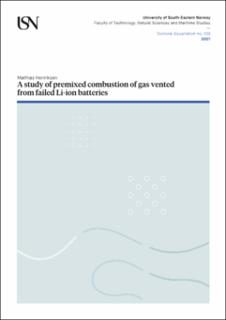A study of premixed combustion of gas vented from failed Li-ion batteries
Doctoral thesis
Published version
Permanent lenke
https://hdl.handle.net/11250/2829351Utgivelsesdato
2021-11-25Metadata
Vis full innførselSamlinger
Sammendrag
As the world moves towards more clean and suitable energy sources such as wind and solar, there is an increasing demand for energy storage systems. Lithium-ion batteries (LIBs) are today the leading electrical energy storage system due to high energy density, high specific energy, and low maintenance requirement compared to other traditional batteries. However, the combination of flammable organic electrolytes and the release of oxygen at elevated temperatures in LIBs presents a potential hazard, with numerous fires and explosions reported in the last decades, where failing LIBs were the cause. This study focuses on the explosion hazards by experimentally and numerically studying the premixed combustion of various gas compositions vented from failing LIBs.
In this study, two experimental setups have been used, a 20-liter explosion sphere and a 1-meter explosion channel. In the 20-liter explosion sphere, the maximum explosion pressure, the maximum rate of explosion pressure rise, and the laminar burning velocity (LBV) have been determined for three electrolyte solvents and three Li-ion vent gas compositions. The results showed that the three electrolyte solvents had very similar explosion characteristics, which were also similar to the propane characteristics. Furthermore, the LBV for all gas compositions analyzed ranged from 0.3 m/s to 1.1 m/s, illustrating the influence of certain vented species and their concentrations on the LBV.
The experimental results obtained from the 1-meter explosion channel were used to evaluate model performance a computational fluid dynamic (CFD) method for simulating an explosion from gases vented from failing LIBs using only open-source software. Three different gas compositions and three different channel geometries have been experimentally and numerically studied. In addition, a code for generating the required CFD parameters for combustion, thermodynamic, and transport properties is presented. Finally, the CFD method gave an overall acceptable model performance when comparing the experimental and numerical temporal evolution of the pressure, maximum pressure, positive impulse, and spatial evolution of the flame front velocity.
Består av
Article A: Henriksen, M., Vågsæther, K., Lundberg, J., Forseth, S. & Bjerketvedt, D.: Explosion characteristics for Li-ion battery electrolytes at elevated temperatures. Journal of Hazardous Materials 371, (2019), 1-7. https://doi.org/10.1016/j.jhazmat.2019.02.108Article B: Henriksen, M., Vågsæther, K., Gaathaug, A.V., Lundberg, J., Forseth, S. & Bjerketvedt, D.: Laminar burning velocity of the dimethyl carbonate–air mixture formed by the Li-ion electrolyte solvent. Combustion, Explosion, and Shock Waves 56(4), (2021), 383-393. https://doi.org/10.1134/S0010508220040024
Article C: Henriksen, M., Vågsæther, K., Lundberg, J., Forseth, S. & Bjerketvedt, D.: Laminar burning velocity of gases vented from failed Li-ion batteries. Journal of Power Sources 506, (2021), 1-11. https://doi.org/10.1016/j.jpowsour.2021.230141
Article D: Henriksen, M., Vågsæther, K., Lundberg, J., Forseth, S. & Bjerketvedt, D.: Simulation of a Premixed Explosion of Gas Vented During Li-Ion Battery Failure. Manuscript submitted to Fire Safety Journal.
Article E: Henriksen, M., Vågsæther, K., Lundberg, J., Forseth, S. & Bjerketvedt, D.: Numerical Study of Premixed Gas Explosion in a 1-meter Channel Partly Filled with 18650 Cell-like Cylinders with Experiments. Manuscript submitted to Journal of Loss Prevention in the Process Industries.
Supplementary Data A: mech2Foam documentation. Published on Figshare, University of South-Eastern Norway, Aug. 17, 2021. https://doi.org/10.23642/usn.13721134.v4

